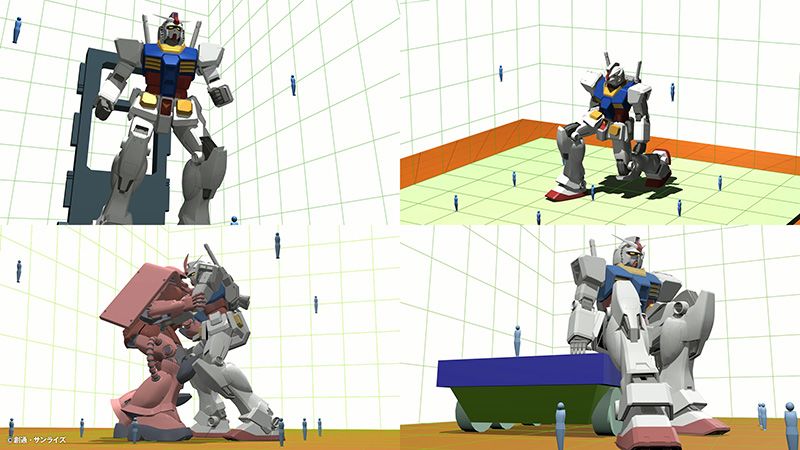
Bringing Gundam to Life: Quest to Build Moving Replica Pushes Limits of Robotics
Science Technology Society Culture- English
- 日本語
- 简体字
- 繁體字
- Français
- Español
- العربية
- Русский
In 2009 an 18-meter high replica of the robotic suit from Mobile Suit Gundam was built in Odaiba, Tokyo, to mark the thirtieth anniversary of the popular anime series. For the fortieth anniversary in 2019, a project team is working to make a version that actually moves.
Taiwanese Scientist Joins Project
The organization Gundam Global Challenge held a press conference in Tokyo in October to announce the four winners in its first competition for ideas of how to make the Gundam mobile. Among them was Taiwanese professor of engineering Chiang Ming-Hsun, who proposed a new mechanism for human-like walking.
Ueno Kazunori, chairman of toy manufacturer Bandai, which is supporting the project, said that, “One in four entries came from overseas, so you can sense how high the global expectations for Gundam are. By turning this project into a reality, we want to help people around the world dream even bigger.”
Kaneko Yūya, who at 24 is the youngest of the Japanese winners, was picked for his idea of having the Gundam grapple with a rival Zaku mobile suit, a regular occurrence in the anime series. The doctoral student felt this would increase the stability of the structure by allowing it to stand on four legs instead of two. The other two winners, Kihara Yoshimitsu and Okada Kei, suggested an externally powered walking system and development of an open platform for Gundam research respectively. The four winners will join the project team and work toward building a moving Gundam.
 Artistic rendering of Gundam movements. (© Sotsu-Sunrise)
Artistic rendering of Gundam movements. (© Sotsu-Sunrise)
“Like Getting a Six-Story Building to Walk”
The original Mobile Suit Gundam series debuted in 1979, spawning later series, films, and manga and video-game adaptations. The most recent version, Tekketsu no orufenzu (Iron-Blooded Orphans), began airing in October 2015. Over the years Gundam became a household name in Japan and won a following overseas, particularly in other Asian countries. It is estimated that of the 11 million Gundam-related plastic models shipped each year, around 30% go to foreign markets.
In the series, each Gundam suit stands 18 meters high and weighs 43.4 tons. Selection board member Hashimoto Shūji, vice president of Waseda University and a professor of applied physics, noted that “eighteen meters is ten times the height of a tall person, and increasing the stature tenfold means a thousandfold increase in weight. Movements like swinging the arms or crossing the legs also require great rotational force to mimic how the anime suits move. To achieve our goals we need to go beyond what robotics has achieved so far.”
At the same time, he showed the will to overcome these problems through engineering, saying, “There are already semi-trailers for carrying extremely heavy loads and systems to stop skyscrapers that are more than 100 meters high from shaking. So there is a solution out there.”
Pitoyo Hartono, a professor at Chūkyō University in Nagoya and one of the project leaders, displayed a similar determination. “Getting an 18-meter robot to walk is like getting a six-story building to walk,” declares Hartono. “A robotics specialist told me that it’s simply impossible. But the word ‘challenge’ is fitting for this kind of wild scheme. To present, the challenges have just been on paper, but now we’ve got to turn them into reality. We’re looking to make a breakthrough.”
Spin-Off Technologies
Why attempt such a quixotic task? Miyagawa Yasuo, president of Sunrise, the animation studio that produces Gundam, compared the undertaking to the Apollo Program that landed men on the moon. “Through the program,” says Miyagawa, “NASA developed a lot of new technologies. Making a Gundam that moves may not be meaningful for robotics in itself, but I feel that the trial-and-error process could help to advance robotic technologies.”
The Japanese government is also backing the project. In January 2015, discussion began toward establishing a “Gundam zone” with relaxed regulations for conducting experiments in the hope of boosting innovation in Japan’s robotics industry. A moving Gundam would also be a big draw for both domestic and international tourists.
To gather further ideas a second Global Challenge competition opened on November 2 and will run until February 29, 2016. If all goes according to schedule, the basic plan will be determined in autumn 2016 and the final design announced in 2018 before the moving Gundam is unveiled the following year.
Aside from the potential spin-off technologies, Gundam creator Tomino Yoshiyuki believes the project can inspire future generations. “If there’s a moving Gundam in 2019, maybe some children will start thinking ahead to what’s next. For that reason alone, it’s something worth doing.”
(Originally written in Japanese by Nagasawa Takaaki of the Nippon.com editorial department and published on November 10, 2015. Photographs by Ōtani Kiyohide. Banner photo: Three prize winners (center) stand between Gundam creator Tomino Toshiyuki (right) and musician Sugizo (left) who acted as presenter at the press conference on October 26, 2015. © Sotsu-Sunrise.)